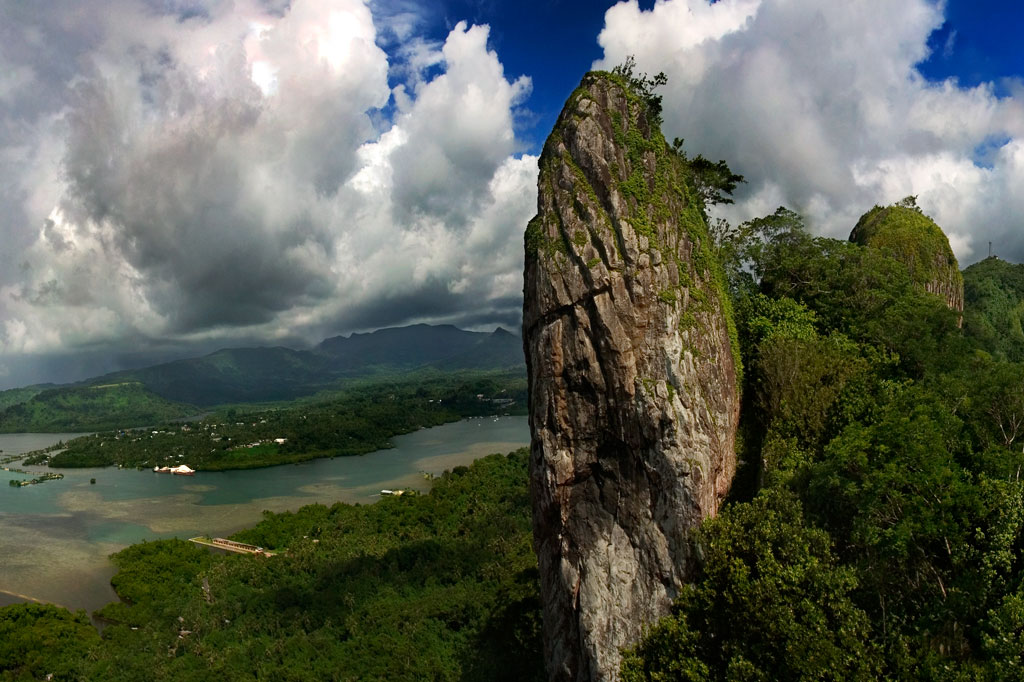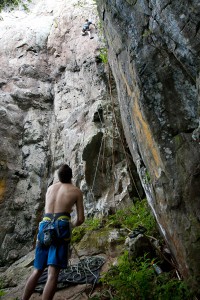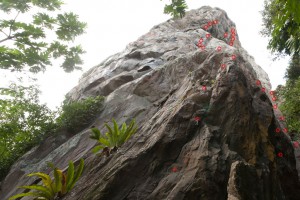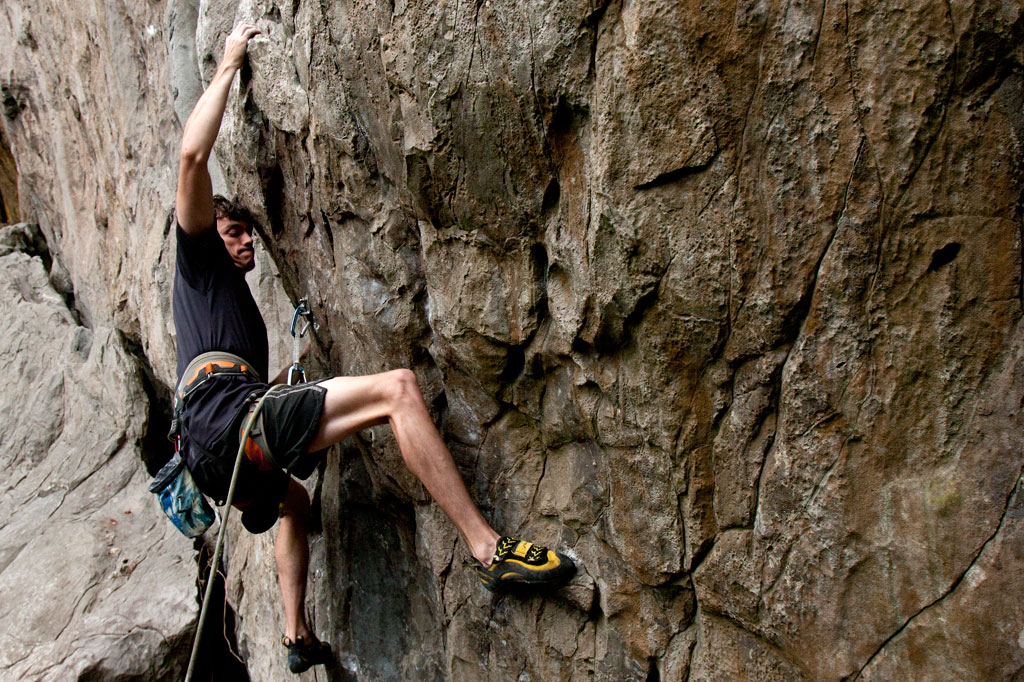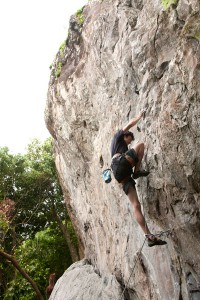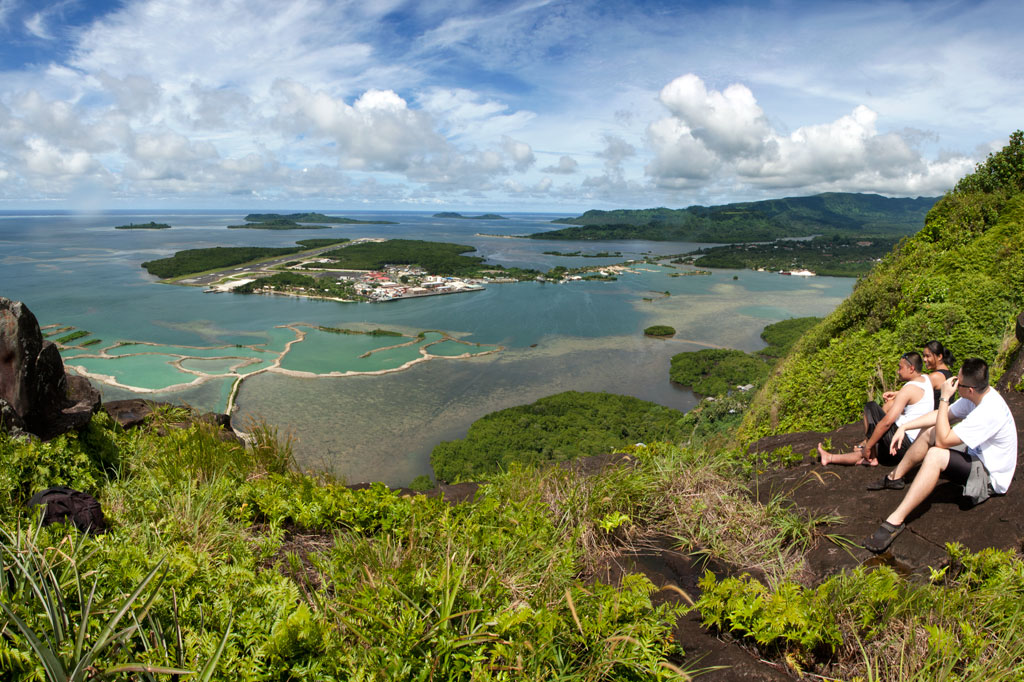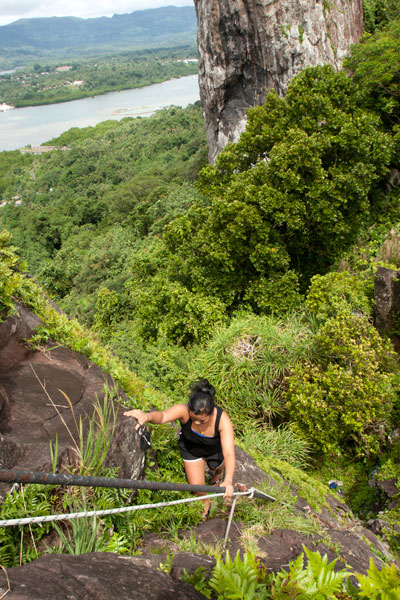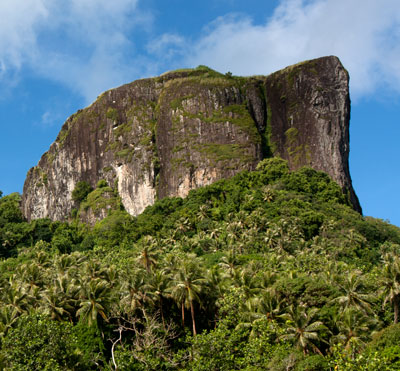The Spire
“The Spire” is exactly what it sounds like — a dagger-like basalt pinnacle rising 50 meters (165 ft) above the top of Sokehs Ridge immediately south of Paipalap. Named in 2005 by Daniel Moor, who scaled the rear of the rock and established a single top-rope bolt, “The Spire” is the kind of crag that just begs to be climbed. It was not climbed again, however, until 2011, when local climbers Matthew Mann and Jonathan White began to explore different route possibilities in earnest. Over the course of more than a year, they bolted four single-pitch sport-climbing ascents on the eastern face. Since that time, “The Spire” has been climbed fairly regularly by members of a small community of climbers living and working on Pohnpei. The emergence of the sport on the island even drew the attention of the local newspaper — well-deserved attention, considering the thought and care Mann and White put into creating these world-class routes. “The Spire” is reached by taking the Sokehs Rock Trail up from the paved road in Danipei (0.38 km, 15-30 minutes) and turning south at the top of the slope.
Rock Consistency & Hardware
The rock itself has a nice texture to it with plenty of friction, but not so much that it tears up the hands. It tends to be solid, not crumbly, and there are lots of sweet little pockets that formed when air bubbles were trapped in the cooling basalt.
Routes
All routes on “The Spire” are well protected with marine-grade bolts and dual double-ring top anchors for top-rope or rappel. Top access is possible via a short route of grade 5.7 which has been bolted on the rear of the rock to provide the means for hauling gear for route-setting and rappel.
| Route | Rating | Length | Hardware in Place | Safety Rating |
| Iron Lungs | 5.12a | 32 m 105 ft |
16 bolts + 2 double-ring top anchors |
G |
| High & Dry | 5.11d | 36.6 m 120 ft |
16 bolts + 2 double-ring top anchors |
G |
| Myxo | 5.12b | 33.5 m 110 ft |
15 bolts + 2 double-ring top anchors |
G |
| No Surprises | 5.11b | 30.5 m 100 ft |
14 bolts + 2 double-ring top anchors |
G |
The Adam’s Apple
Mann and White also discovered a wall about 60 meters south of “The Spire” near Takaien Rikapehd. They named it “The Adam’s Apple“. There are plans to eventually bolt five routes here. As of October 2013, two have been completed. “The Adam’s Apple” routes are short but extreme, as the wall is slightly overhung. This is not a place for beginners.
Routes
| Route | Rating | Length | Hardware in Place | Safety Rating |
| Spies | 5.12b | 15.2 m 50 ft |
5 bolts + 2 double-ring top anchors |
G |
| Genesis | 5.11c | 18.3 m 60 ft |
6 bolts + 2 double-ring top anchors |
G |
Why These Climbs Are Awesome
- EASY ACCESS. A 10 minute drive from Kolonia Town + a 20 minute hike from the road = ready to climb.
- NO FEES. Though the Sokehs Rock Trail (which leads to all the sites) begins next to a private residence, the landowners charge nothing for access. Just ask permission, if you see anyone at the house.
- PUBLIC ROUTES. The climbing sites are all on public property and no permission is needed to be there.
- SHELTERED FROM WIND & RAIN. The eastern faces of the rocks, where all the routes lie, are saved from the prevailing winds by the bulk of the ridge and stay mostly dry even after heavy rain.
- SHADE. The routes are in direct sun only early in the morning, so you can sleep in or have a nice, leisurely breakfast before heading up.
- A LITTLE OF EVERYTHING. The rock consists of weathered basalt with all sorts of interesting pockets, jugs, pinches, slopers, cracks, and edges.
- THEY’RE WORLD-CLASS. Route-finders Matthew Mann and Jonathan White were adamant that all routes be of exceptional quality and highly challenging. There are no throw-away climbs. Everything here will test your limits.
- Visit www.pohnpei-adventure.com/rockclimbing for more about climbing on Pohnpei.


